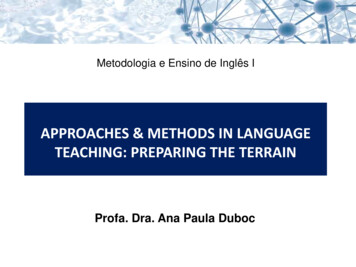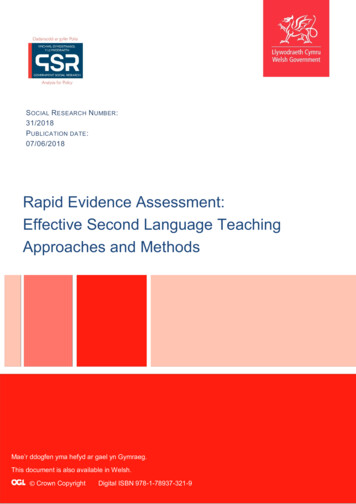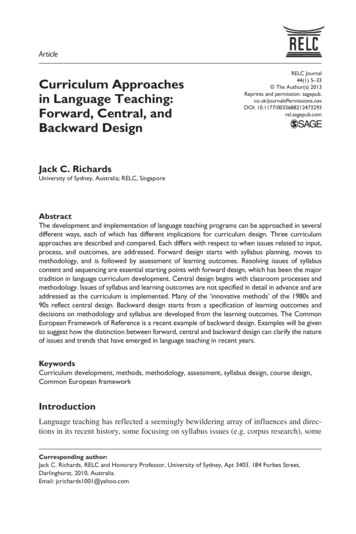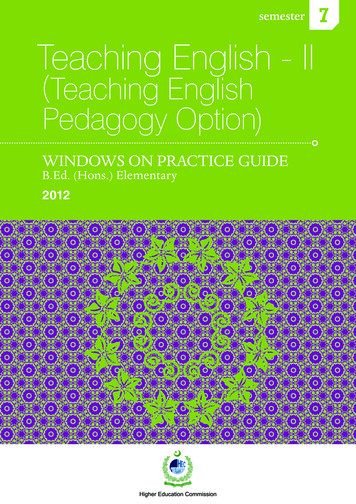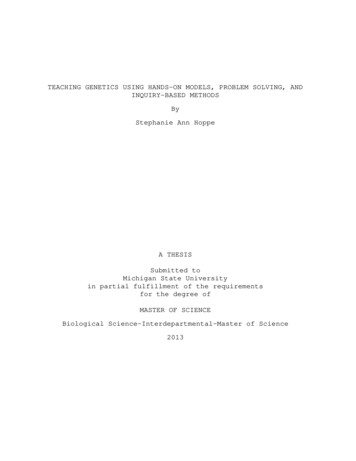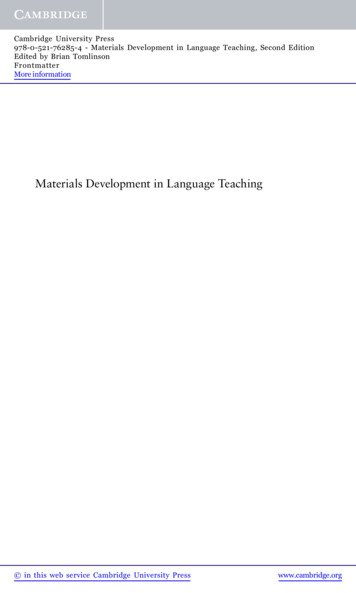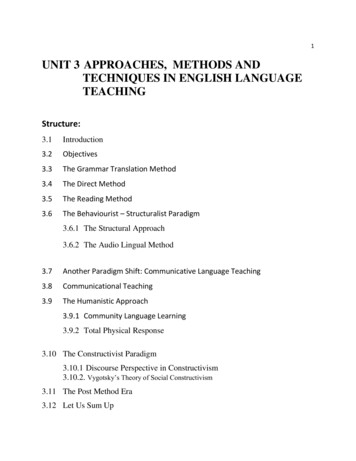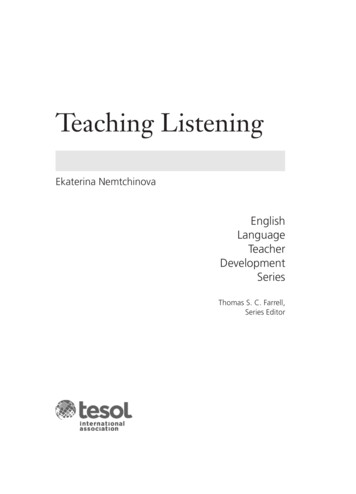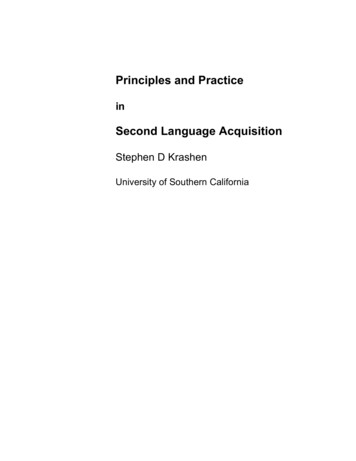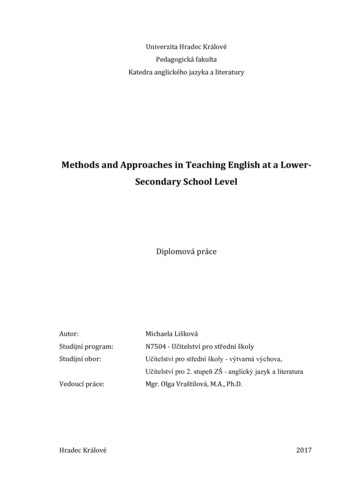
Transcription
Univerzita Hradec KrálovéPedagogická fakultaKatedra anglického jazyka a literaturyMethods and Approaches in Teaching English at a LowerSecondary School LevelDiplomová práceAutor:Michaela LiškováStudijní program:N7504 - Učitelství pro střední školyStudijní obor:Učitelství pro střední školy - výtvarná výchova,Učitelství pro 2. stupeň ZŠ - anglický jazyk a literaturaVedoucí práce:Hradec KrálovéMgr. Olga Vraštilová, M.A., Ph.D.2017
ProhlášeníProhlašuji, že jsem tuto diplomovou práci vypracovala pod vedením vedoucídiplomové práce Mgr. Olgy Vraštilové, M.A., Ph.D., samostatně a uvedla jsem všechnypoužité prameny a literaturu.V Hradci Králové dne:Podpis studenta:
ProhlášeníProhlašuji, že diplomová práce je uložena v souladu s rektorským výnosemč. 1/2013 (Řád pro nakládání se školními a některými jinými autorskými díly na UHK).Datum:Podpis studenta:
PoděkováníTímto bych ráda poděkovala své vedoucí diplomové práce Mgr. OlzeVraštilové, M.A., Ph.D. za její odbornou pomoc, cenné rady a poskytnuté materiály,které mi pomohly při zpracování diplomové práce.
AnotaceLIŠKOVÁ, Michaela. Metody a přístupy ve výuce anglického jazyka na 2.stupni základní školy. Hradec Králové: Pedagogická fakulta, Univerzita HradecKrálové, 2017. 110. Diplomová práce.Diplomová práce se zabývá výukovými metodami a přístupy ve výuceanglického jazyka jako druhého a cizího jazyka na druhém stupni základních školv České Republice a Velké Británii.Teoretická část práce charakterizuje nejznámější metody a přístupy ve výuceanglického jazyka, jejich stručný vývoj, hlavní znaky, a současné trendy. Pozornost jevěnována i charakteristice žáka druhého stupně základní školy. Praktická část jezaložena na dotazníkovém šetření směřujícím k učitelům anglického jazyka na druhémstupni ZŠ.Cílem práce bylo zjistit, jak je učitelská veřejnost obeznámena s novýmipřístupy a metodami ve výuce anglického jazyka, jaké metody a přístupy jsou aktuálněpoužívány ve výuce anglického jazyka v České Republice a Velké Británii, jaké učebnímateriály jsou používány a zdali mají vyučující zájem o nové metody a přístupy v ELT.Klíčová slova: vyučování, jazyk anglický, metoda, přístup, 2. stupeň základní školy
AnnotationLišková, Michaela. Methods and Approaches in Teaching English at a LowerSecondary School Level. Hradec Králové: Faculty of Education, University of HradecKrálové, 2017. 110. Diploma thesis.The diploma thesis addresses methods and approaches to teaching Englishas a second and foreign language at lower-secondary school level in the Czech Republicand Great Britain.The theoretical part of the thesis describes popular methods and approaches to ELT,their main features, development and current trends in language teaching. Attention ispaid to lower-secondary school pupil characteristics as well. The practical part is basedon a questionnaire research towards English language teachers at lower-secondaryschool level.The objective of the diploma thesis was to determine how is the teaching publicaware of the new approaches and methods used in ELT, what methods and approachesare currently being used in ELT in the Czech Republic and Great Britain, and whetherthe teachers are interested the latest trends in the ELT methodology. The thesis is berealised in English language.Key words: teaching, English language, method, approach, lower-secondary schoollevel
ContentsList of pictures . 10List of abbreviations . 12Introduction . 13Theoretical part . 151Characteristics of the target group of learners . 152Approaches, Methods and Techniques . 183Classification of approaches . 204Approaches. 234.1The Grammar-Translation Approach . 244.2The Direct Approach . 264.3The Reading Approach . 284.4The Oral-Situational Approach. 304.5Audiolingualism . 3211.1.1Presentation, Practice and Production Procedure . 354.6The Cognitive Approach . 364.7The Communicative Approach, CLT . 375Methods . 425.1Total Physical Response . 435.2The Silent Way . 465.3Suggestopedia . 486Current trends in ELT . 517The choice of a method . 538Methods and teaching materials . 55Summary of the theoretical part. 57Practical Part . 599Aims of the research . 59
10Researched sample . 6011Survey method and its limits. 6111.1 The questionnaire . 6311.1.112The form of the questions . 63The analysis of the survey material. 6512.1 Questions 1 and 2 . 6512.2 Questions 3 and 4 . 6712.3 Question 5 . 6912.4 Question 6 . 7012.5 Question 7 . 7212.6 Question 8 . 7312.7 Question 9 . 7412.8 Question 10 . 7612.9 Question 11 and 14 . 7612.10 Question 12, 13, and 15 . 7912.11 Question 16 . 8412.12 The length of teaching experience . 8613Formulation of findings and research results . 9013.1 The Czech model . 9013.2 The British model . 9214Resources for English language teachers . 94Conclusion . 97Bibliography . 100AppendicesAppendix A- Czech questionnaireAppendix B – English questionnaire
List of picturesGraph 1: Question 2: English category: The length of teaching experience. . 66Graph 2: Question 2: Czech category: The length of teaching experience. 66Graph 3: Question 3 – Czech category: Translation of texts into . 67Graph 4: Question 4 - English category: Use of pupil s mother tongue in the classroom. 68Graph 5: Question 4 - Czech category: Use of pupil s mother tongue in the classroom. 68Graph 6: Question 5 – English category: How do you learn about the latestmethodology in teaching English as a second language? . 69Graph 7: Question 5 – Czech category: How do you learn about the latest methodologyin teaching English as a foreign language? . 70Graph 8: Question 6 – English category: The inductive versus deductive approach togrammar instruction. . 71Graph 9: Question 6 – Czech category: The inductive versus deductive approach togrammar instruction. . 71Graph 10: Question 7 – English category: Errors versus accuracy. . 72Graph 11: Question 7 – Czech category: Errors versus accuracy. . 73Graph 12: Question 8 – Czech category: Group and pair work. . 73Graph 13: Question 9 – English category: Role of the teacher in the classroom. . 74Graph 14: Question 9 – Czech category: Role of the teacher in the classroom. 75Graph 15 : Question 10 – Czech category: Usage of visual aids in the classroom. 76Graph 16: Question 11 – English category: The sequence of the four basic languageskills in ELT. 77Graph 17: Question 11 – Czech category: The sequence of basic language skills in ELT. 78Graph 18: Question 14 – English category: The importance of the four basic languageskills. . 78Graph 19: Question 14 – Czech category: The importance of the four basic languageskills. . 79Graph 20: Question 12 – English category: The prominence of particular activities inELT. . 80
Graph 21: Question 12 – Czech category: The prominence of particular activities inELT. . 80Graph 22: Question 13 – English category: The main objective of my ELT. . 82Graph 23: Question 13 – Czech category: The main objective of my ELT. . 82Graph 24: Question 15 – English category: Teaching principles. . 83Graph 25: Question 15 – Czech category: Teaching principles. . 84Graph 26: Question 16 – English category: A textbook and other teaching materials inELT. . 85Graph 27: Question 16 – E category: A textbook and other teaching materials in ELT. 85Graph 28: Question 5: Czech category: Answers of the teachers of the 0 – 3 category. 86Graph 29: Question 5: Czech category: Answers of the teachers of the 4 – 9 category. 87Graph 30: Question 5: Czech category: Answers of the teachers of the 10 category. . 87Graph 31: Question 5: English category: Answers of the teachers of the 4 – 9 category. 88Graph 32: Question 5: English category: Answers of the teachers of the 10 category. 88
List of abbreviationsCLLCommunity Language LearningCLTCommunicative Language Teachinge.g.For exampleEFLEnglish as a Foreign LanguageELTEnglish Language TeachingESAEngage, Study and Activateetc.Etcetera; and so onICTInformation and communications technologyL1Mother tongue; the first language of the learnerL2The second language; target language; foreign languageNATECLANational Association for Teaching English and Community Languagesto AdultsSLTSituational Language TeachingTEFLTeaching English as a foreign languageTESLTeaching English as a second languageTlThe target language; the second language; foreign languageTPRTotal Physical ResponseUKThe United Kingdom
IntroductionThe English teaching methodology is a very complex and constantly developingand changing system of theories, hypotheses, assumptions about language and learning,and methods and approaches to teaching. In order to enhance and facilitate the teachinglearning process, the ELT methodology attempts to explore and answer how the languageworks, how the memory works, and to seek what teaching is and what learning is, whatis taught and how, what are the objectives of the teaching-learning process and how to reachthem effectively, and how to facilitate and enhance learning. Various methods and approachesthat have been developed so far are an attempt to answer these questions.The thesis Methods and Approaches in Teaching English at Lower-Secondary SchoolLevel introduces a few of these methods and approaches to the reader in the context of someof the mentioned questions. The thesis tries to determine what methods and approachesare currently being used in English language classes and whether the language teachersare interested in the latest trends in the ELT methodology. The theoretical dataabout the presented approaches and methods are complemented by the currently usedpractices of English language teaching at a lower-secondary school level by teachers teachingEnglish as a second and foreign language in the Czech Republic and the United Kingdom thatwere collected via a questionnaire. The work includes a survey aiming to find out whatpractices are currently being used in ELT at lower-secondary schools in the Czech Republicand the UK, subsequently comparing both. Only such teachers in the United Kingdomare addressed with the questionnaire who teach English as a second language at lowersecondary school level to provide relevant data for the survey. The survey includesthe teachers teaching English as a second language in the UK to gain a greater varietyof opinions on the subject matter and to provide a wider choice and inspiration for the reader.The thesis aims to describe a few of the most significant approaches and methods thatappeared until today as well as some of the current trends in the English language teaching.The thesis operates with three key terms: approach, method, and technique. Their definitionsand relationships are presented in Chapter two to avoid possible confusion causedby the variety of the definitions of these concepts since various authors define themdifferently.13
The thesis deals with the selected methods and approaches to teaching Englishat lower-second schools and, therefore, also presents and characterizes a lower-secondaryschool pupil. The thesis also examines the relationship between the methods and approachesand teaching materials. The reader can also find various possible resources for teachersdealing with the ELT methodology and the latest trends in it as gained from the survey.The presented approaches, as well as methods, are defined in terms of their principles,understanding of the nature of the language and characteristics of the teaching-learningprocess, the roles of a teacher and learners, the goals of the language instruction, the ratioof the usage of the target and the native language, the prominence of a particular languageskill, and in some cases the teaching environment. The list of the methods and approachesis by no means exhaustive and depicts only a fraction of the whole variety of the ELTmethodology.I have chosen the topic of the thesis concerning the ELT methodology becauseI myself am looking for the best method and approach to ELT. In order to develop my ownteaching and enrich my own teaching practice and hopefully even the reader s knowledge,I decided to look into the subject matter and found it exceedingly interesting and inspiringand occasionally confusing since various authors use different and sometimes evencontradictory terminology.Chapters four and five mainly draw from Richards and Rogers (1986), LarsenFreeman (2000), and Harmer (1988). The bibliographic references in the text are phrasedfollowing the model of Harmer (1988) and Richards and Rogers (1986, 2001).14
Theoretical partThe theoretical part of the work introduces the target group of learners sincethe practical part of the paper is focused on finding out what approaches and methods aremostly used in English language classes at lower-secondary school level in the CzechRepublic and the United Kingdom.The concepts of an approach, method, and technique are defined to avoid confusionbecause different authors of popular methodology literature define these terms differently.The theoretical part also contains chapter dealing with conditions of a choice of a suitablemethod and questions the role of teaching materials, their benefits for the teaching processas well as their disadvantages.1 Characteristics of the target group of learnersThe target group of learners in this thesis is the one of younger adolescents. Thoseare namely pupils of lower-secondary schools since the research part of this work focuseson lower-secondary school pupils. This designation refers to the Czech educational systemof primary and secondary schools. Pupils aged approximately from six until nine attendprimary schools. Primary schools directly continue in lower-secondary schools with pupilsfrom the age of ten until fifteen. Primary and lower-secondary education is a partof compulsory education.The factor of age plays an important role in the decisions about what and how to teachin the class and therefore also the choice of teaching methods, procedures, and techniques.A teacher must know about the specification of the target group of learners and take thatinto consideration. This age group of learners has a great disposition for learning. Apart froma superior ability to learn pronunciation they are much better at understanding and absorbingthe language than young learners mainly because of their increased cognitive skillsand abstract thinking. They are able to operate in abstract concepts, which is very importantin terms of language learning as for example in understanding grammar rulesor understanding abstract terms. Their attention span is significantly longer and on thataccount, the teacher does not have to change activities that often as with young learners.Pupils at the age of approximately ten and on are usually happy to work in groups15
in comparison to young learners that prefer working alone. This however greatly dependson individual preferences and pupil s personality, too.Learners of this age group are often seen as the most difficult or challenging onesbecause of puberty and all the changing factors around it. Pupils gradually become moreaware of themselves and the mistakes they make or might make for instance, which causesthem being more reluctant to share their opinions, not to mention speaking in front of thewhole class. The pupils are often worried and uncertain about their self-esteem and selfpresentation which makes them feel insecure and therefore unwilling to express themselvesor participate in the lesson. The teacher then needs to acknowledge this type of inhibitions andwork with them to make the learning process happen successfully. Younger adolescents aresearching for their identity in the world and their own place as well as opinions. They longfor peer approval and belonging into any group, where they can feel secure and accepted.In the terms of engagement of the pupils, relevance, authenticity, and meaningfulnessare the key terms. If the teacher wants their pupils to be engaged, they need to present a topicin a way that is relevant to their pupils lives and authentic. It is always wise to show thatthe topics learnt at school are connected to their lives outside of the class, even better whenit engages their hobbies and interests which lead to positive motivational belief.As for the motivation of lower-secondary pupils, the teachers do not have to dependonly on extrinsic motivation, as it usually is with younger learners. The motivation of youngeradolescents moves from purely extrinsic into intrinsic motivation that includes their owndesire to do things without any external influences, such as punishments or rewards.The intrinsic motivation can be positively influenced by the teacher s presentation of the pieceof language and his classroom management. It is always good to set up short term goals.Those goals are achievable and when pupils achieve them, they feel successful and motivatedto aim for another goal. It is also profitable to include pupils in negotiating those goals to keepthem involved and feeling responsible. Topics that are shown as useful, interestingand corresponding with their lives and their own desires and a proper feedback should keeppupils highly motivated and potentially lead to the desire to study more.Lower-secondary learners are already much more independent and for this reason,it is good to engage them into the classroom management, particularly speaking, to createthe classroom rules together with the students themselves. The key thing then is to stickup to those rules at all times and they should work for everyone the same. That should lead16
to the classroom environment where everyone feels secure and valued, which is veryimportant for younger adolescents.Even though the class is made out of pupils of approximately same age, they all arestill individuals with different learning strategies, different motivation, personalities, talents,interests, learning preferences and sometimes slightly different language proficiency levels.So on top of the knowledge of the age group specifications, the teacher needs to see eachof their students as an individual, even though it certainly is not easy at all.In the following chapters, the recipients of the learning process will be consideredand presented without the age specification or focus on a particular age group. There willbe only an occasional note about a method employment for a particular age group of learnersif the specification of the method, approach or theory requires it. Language learners willbe referred to as learners, pupils or students in the following chapters.17
2 Approaches, Methods and TechniquesTheway in whichthetargetlanguageis deliveredessentially affectsthe pupil s attitude to learning it and without a doubt the result, success or failureof the learning process. Therefore a great number of methods and approaches have beendeveloped so far, as well as a wealth of techniques and procedures, along with languagetheories and theories of learning, to improve the language teaching. Language specialists,linguists and methodologists were and are constantly and unflaggingly seeking for the bestway of delivering the language to the pupils.But in order to understand the nature of approaches and methods, it is importantto clarify the relationship between approach, method, and technique. This chapter is to clarifythe previously mentioned and to show how approach, method, and technique are related.American applied linguist Edward Anthony identified three levels of organizationof the language teaching in 1963. He termed those concepts approach, method, and techniqueand arranged them hierarchically (Richards 1991: 15).“The organizational key is that techniques carry out a method which is consistentwith an approach An approach is a set of correlative assumptions dealing with the natureof language teaching and learning. An approach is axiomatic. It describes the natureof the subject matter to be taught Method is an overall plan for the orderly presentation of language material, no partof which contradicts, and all of which is based upon, the selected approach Within oneapproach, there can be many methods A technique is implementational – that which actually takes place in a classroom. It isa particular trick, stratagem, or contrivance used to accomplish an immediate objective.Techniques must be consistent with a method and therefore in harmony with an approachas well” (Anthony 1963:63-7, in Richards 1968:15).Following Anthony and putting the subject matter in the context of other authors,Richards and Rodgers (1968), Mackey (1965), Harmer (2008), referring to it, and to generallydefine those terms, it can be stated, that an approach is an overall attitude in the processof teaching and learning. An approach describes the way language works, how the knowledgeof the language is acquired and the conditions influencing successful language learning.18
A method is an instrument of teaching within an approach, a practical realisationof the overall mood of an approach. The method includes processes happeningin the classroom, selection of the content of teaching, teacher s roles, learner s roles, the roleof instructional materials and types of tasks and activities employed in the classroom.The method follows the attitude of the approach and fulfils its objectives through proceduresthat include practices, behaviours, and techniques.The technique, strategy, and tactic used in the language classroom, is an elementcontained in a procedure of a particular method. Techniques are a practical realisationof the method that include different practices and activities of all possible sorts, servingthe purposes of the method implied. If there are many approaches there are many methods,and therefore, there is an enormous number of techniques used within language teachingand learning. There are, for example, viewing techniques, listening techniques, mixed onesused in the procedures of the certain methods.Richards and Rogers (2001) proposed a reformation of the concept of a method, wheretheir method relates more to a methodology. Approach, design, and procedure are subordinateterms to the method according to Richards and Rogers. These contradicting ideasabout the e,referto Grammar-Translation as an approach and others as a method. The definitionof the Grammar-Translation Approach or Method is the same in both cases, what differsis the overall understanding of the definitions of approach and method themselves.For the purposes of this work, let those terms be stated as it has been earlier in thischapter following Anthony s definition (1963) even though some methodologistsand methodology books slightly differ in defining them. However covering the whole rangeof opinions on the subject would only lead to confusion and would not create an intelligibleframe for the following classification of major approaches and methods.19
3 Classification of approachesThis chapter offers a brief introduction to approaches and methods in Englishlanguage teaching from the historical point of view. More details of each approachand method will be given in the following chapters.Richards divides the development of ELT methodology into three major periods.The first period is a period of Traditional Approaches to English language teaching that lastsapproximately up to the 1960s. The traditional approaches are followed by ClassicCommunicative Language Teaching from the 1970s till the 1990s, and from the late 1990son comes the period of, in Jack Richards phrase, Current Communicative Language Teaching(2006: 6-12).Traditional approaches like the Grammar-Translation, the Direct Approach,the Cognitive Approach, the Oral-Situational Approach and the Reading Approach referto the methodology used till approximately the 1960s. Celce-Murcia points out that thosetraditi
The diploma thesis addresses methods and approaches to teaching English as a second and foreign language at lower-secondary school level in the Czech Republic and Great Britain. The theoretical part of the thesis describes popular methods and approaches to ELT, their main features, development
